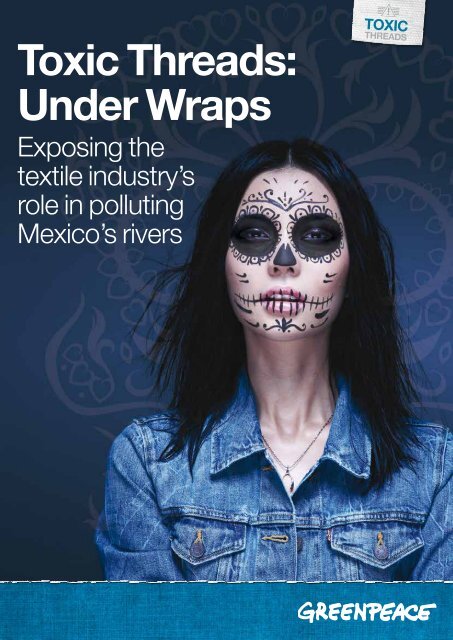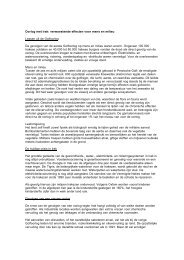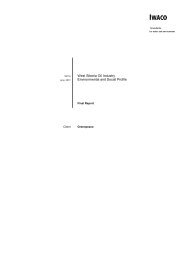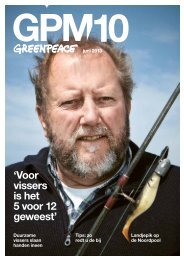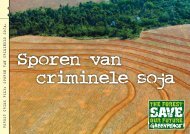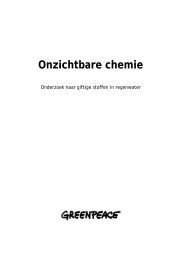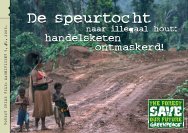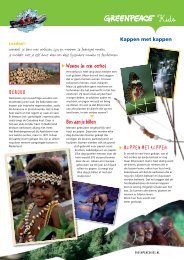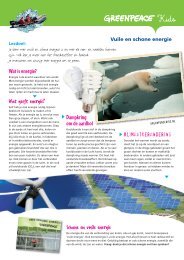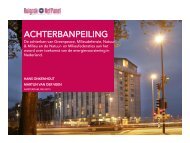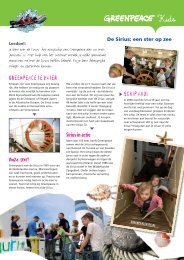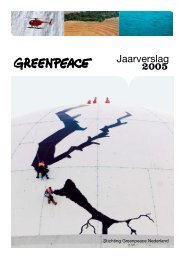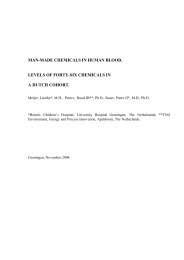Toxic Threads: Under Wraps - Greenpeace
Toxic Threads: Under Wraps - Greenpeace
Toxic Threads: Under Wraps - Greenpeace
Create successful ePaper yourself
Turn your PDF publications into a flip-book with our unique Google optimized e-Paper software.
<strong>Toxic</strong> <strong>Threads</strong>:<br />
<strong>Under</strong> <strong>Wraps</strong><br />
<strong>Toxic</strong><br />
<strong>Threads</strong><br />
Exposing the<br />
textile industry’s<br />
role in polluting<br />
Mexico’s rivers
section xxx<br />
image © Marizilda Cruppe / <strong>Greenpeace</strong><br />
Contents<br />
1. Unmasking Mexico’s textile pollution 5<br />
2. Two Mexican denim manufacturers investigated 9<br />
3. Water pollution in Mexico 17<br />
4. Mexican textiles industry and global fashion brands 21<br />
5. Time to Detox Mexico’s waterways 25<br />
Endnotes 28<br />
Acknowledgements:<br />
We would like to thank the following people who contributed to the creation of this report. If we have forgotten anyone, they<br />
know that our gratitude is also extended to them.<br />
Kevin Brigden, Alejandro Cadena, Kristin Casper, Madeleine Cobbing, Maria Colin, Tommy Crawford, Alexandra Dawe,<br />
Steve Erwood, Raúl Estrada, Nadia Haiama, Martin Hojsik, Christian Rojas, Tony Sadownichik, Angelica Simón, Pierre Terras,<br />
Ieva Vilimaviciute, Alex Yallop<br />
Front cover image photo: Lance Lee<br />
Back cover image: Mexican models Juanjo Herrera and Gala Koksharova show their support for the Detox campaign in a<br />
<strong>Greenpeace</strong> “cat walk” action in Mexico, November 2012. © Ivan Castaneira / <strong>Greenpeace</strong><br />
Art Direction & Design by: Toby Cotton @ arccomms.co.uk<br />
<strong>Toxic</strong> <strong>Threads</strong>: <strong>Under</strong> <strong>Wraps</strong><br />
JN 429c<br />
Published December 2012<br />
by <strong>Greenpeace</strong> International<br />
Ottho Heldringstraat 5,<br />
1066 AZ Amsterdam,<br />
The Netherlands<br />
greenpeace.org<br />
Terminology used in this report<br />
Bioaccumulation: The mechanism by which chemicals<br />
accumulate in living organisms and get passed along the<br />
food chain.<br />
Hormone disruptors: Chemicals known to interfere<br />
with hormone systems of organisms. For nonylphenol,<br />
the most widely recognised hazard is the ability to mimic<br />
natural oestrogen hormones. This can lead to altered<br />
sexual development in some organisms, most notably the<br />
feminisation of fish*.<br />
Persistence: The property of a chemical whereby it does not<br />
degrade in the environment, or degrades very slowly.<br />
Surfactants: Chemicals used to lower the surface tension of<br />
liquids. They include wetting agents, detergents, emulsifiers,<br />
foaming agents and dispersants used in a variety of industrial<br />
and consumer applications including textile manufacture.<br />
*Jobling S, Reynolds T, White R, Parker MG & Sumpter JP (1995). A variety of environmentally persistent chemicals, including some phthalate plasticisers, are weakly<br />
estrogenic. Environmental Health Perspectives 103(6): 582-587; Jobling S, Sheahan D, Osborne JA, Matthiessen P & Sumpter JP (1996). Inhibition of testicular growth<br />
in rainbow trout (Oncorhynchus mykiss) exposed to estrogenic alkylphenolic chemicals. Environmental <strong>Toxic</strong>ology and Chemistry 15(2): 194-202.<br />
2 <strong>Greenpeace</strong> International <strong>Toxic</strong> <strong>Threads</strong>: <strong>Under</strong> <strong>Wraps</strong>
In Mexico, there is a culture of secrecy, especially where<br />
industry is concerned. Much of the information about<br />
companies , permits to discharge effluent, and government<br />
inspections, is classified as confidential...<br />
Textiles and<br />
toxic chemicals<br />
#1<br />
<strong>Greenpeace</strong> International <strong>Toxic</strong> <strong>Threads</strong>: <strong>Under</strong> <strong>Wraps</strong> 3
section one<br />
image © Marizilda Cruppe / <strong>Greenpeace</strong><br />
4 <strong>Greenpeace</strong> International <strong>Toxic</strong> <strong>Threads</strong>: <strong>Under</strong> <strong>Wraps</strong>
image Industrial pollution of<br />
the River Santiago, one of the<br />
most important watersheds in<br />
the state of Jalisco, Mexico.<br />
<strong>Toxic</strong><br />
<strong>Threads</strong><br />
#1<br />
Unmasking Mexico’s<br />
textile pollution<br />
Textile manufacturing is a global business,<br />
and a major contributor to water pollution.<br />
<strong>Greenpeace</strong> International has been taking a closer look at<br />
textile manufacturers outside China to demonstrate that<br />
the problem is not limited to Asia. This first investigation<br />
into textile manufacturing facilities in Mexico has found a<br />
wide range of hazardous substances in wastewater being<br />
discharged from two facilities 1 . Both are involved in the<br />
manufacture and pre-sale washing of textile products in<br />
Mexico: the Lavamex facility located in Aguascalientes<br />
and the Kaltex facility in San Juan del Río, Queretaro. Wet<br />
processes, such as the dyeing and washing of denim<br />
textiles, are carried out at both of these facilities. 2<br />
Mexico is one of the largest producers of denim in the<br />
world, and a major supplier to the US market. 3 It is,<br />
therefore, an important country for textile manufacturing.<br />
As a developing country that is particularly susceptible to<br />
the effects of climate change, with many inequalities and<br />
inadequate regulations and enforcement, water resources<br />
in Mexico are especially vulnerable.<br />
Water is considered sacred in Mexican culture, yet it is<br />
under threat from many environmental pressures, including<br />
pollution to such an extent that people suffer from water<br />
scarcity. More than 70% of freshwater resources in Mexico<br />
are affected by pollution from all sources, and concerns<br />
about health effects from water pollution have led to<br />
conflicts in several parts of the country. 4<br />
This report builds on previous reports by <strong>Greenpeace</strong><br />
International (see Box 1) that have investigated the<br />
discharge of hazardous substances in the effluent of textile<br />
manufacturing facilities in China, both in direct discharges<br />
to waterways and in communal discharges from industrial<br />
zones, where a high proportion of textile manufacturers are<br />
located.<br />
<strong>Greenpeace</strong> International <strong>Toxic</strong> <strong>Threads</strong>: <strong>Under</strong> <strong>Wraps</strong> 5
section one<br />
image Lavamex<br />
facility entrance<br />
© Guadalupe<br />
Szymanski /<br />
<strong>Greenpeace</strong><br />
Kaltex,<br />
San Juan del Rio<br />
Lerma-<br />
Chapala-<br />
Santiago<br />
river basin<br />
Aquascalientes<br />
Panuco<br />
river<br />
basin<br />
image Kaltex facility<br />
in San Juan del Río<br />
© Guadalupe<br />
Szymanski /<br />
<strong>Greenpeace</strong><br />
Santiago<br />
River<br />
Guadalajara<br />
San Pedro<br />
River<br />
Queretaro<br />
San Juan<br />
River<br />
Mexico City<br />
Puebla<br />
Lavamex<br />
Balsas<br />
river<br />
basin<br />
Tehuacan<br />
Key findings<br />
A diverse range of chemicals was identified in the<br />
wastewater samples, many with known hazardous<br />
properties. Some are toxic to aquatic life, while others<br />
are persistent and will therefore remain in the environment<br />
long after their release.<br />
The Lavamex facility was the most notable in terms of<br />
hazardous chemicals identified in wastewater samples.<br />
In particular, nonylphenol (NP) was found, along with<br />
nonylphenolethoxylates (NPEs). NPEs are used as<br />
detergents and surfactants in textiles manufacturing<br />
and later can degrade back to NP. NP is a well-known<br />
persistent environmental contaminant with hormone<br />
disrupting properties. Other substances found included<br />
the hazardous chemicals benzotriazoles, tributyl<br />
phosphate and trichloroaniline, which are toxic to<br />
aquatic life.<br />
TMDD, a surfactant used in dye formulations among<br />
other things, was found in the effluent of both facilities<br />
(see Box 4). TMDD is persistent in the aquatic<br />
environment and moderately toxic to aquatic life. Another<br />
hazardous chemicals found at the Kaltex facility was<br />
hexa(methoxymethyl)melamine (HMMM) – used to<br />
produce resins – which is moderately toxic to aquatic life.<br />
Traces were also detected of two trichlorinatedbenzenes,<br />
widely recognised persistent toxic chemicals that are<br />
used as solvents and dye carriers, and the phthalates<br />
di-2-ethylhexyl phthalate (DEHP) and diisobutylphthalate<br />
(DiBP) as minor components, which are reproductive<br />
toxins with numerous industrial uses, including in the<br />
manufacture of textiles. However, for these two phthalates,<br />
sources other than textile manufacture cannot be<br />
altogether excluded.<br />
Many of the chemicals identified are used during textile<br />
manufacturing processes, or are created as a result of the<br />
breakdown of chemicals used in textiles processing. Some<br />
of the hazardous chemicals identified in this study have<br />
also previously been reported by <strong>Greenpeace</strong> in industrial<br />
wastewaters discharged in China (see Box 1), including<br />
those released from textile manufacturing facilities.<br />
As well as finding hazardous substances from the two<br />
manufacturing facilities investigated, this report also<br />
reveals that while all types of water pollution in Mexico<br />
are a problem, the full extent of pollution by hazardous<br />
substances is unknown. Regulation is limited and there is<br />
little enforcement.<br />
6 <strong>Greenpeace</strong> International <strong>Toxic</strong> <strong>Threads</strong>: <strong>Under</strong> <strong>Wraps</strong>
section one<br />
In Mexico, there is a culture of secrecy, especially<br />
where industry is concerned. Much of the information<br />
about companies’ permits to discharge effluent and<br />
government inspections is classified as confidential. An<br />
extensive study commissioned by the government into<br />
pollution of the Santiago river basin was also considered<br />
confidential. To obtain these basic documents – including<br />
those concerning discharges of effluent from the facilities<br />
investigated in this study – <strong>Greenpeace</strong> Mexico had to<br />
request for them to be disclosed, a lengthy and frustrating<br />
process.<br />
The Lavamex and Kaltex facilities are only two<br />
examples of what is likely to be a more widespread<br />
problem of hazardous substances in the effluent of<br />
textile manufacturers, as well as other industrial sectors<br />
in Mexico, where there is little information about the use<br />
of hazardous substances in production processes or<br />
their release in wastewater. Some of the responsibility<br />
for this problem lies beyond the facilities concerned and<br />
government authorities.<br />
The investigation found that several global fashion brands<br />
have business relationships with these two facilities, either<br />
currently or in the recent past. To solve this problem,<br />
transparency of information between suppliers and<br />
brands, as well as full supplier engagement through<br />
hazardous substance-use inventories, is needed and<br />
should be enforced. Corporate and governmental policies<br />
to eliminate the releases of hazardous substances and<br />
their substitution with safer alternatives also need to be<br />
enforced.<br />
It is equally vital to have full facility public disclosure,<br />
in line with the right-to-know principle. 5 This will create<br />
wider and deeper awareness within local populations<br />
and provide critically needed information for civil society<br />
organisations and local citizens. 6 It will also build<br />
societal awareness and lead to informed pressure for<br />
comprehensive chemical management laws. Companies<br />
have a duty, therefore, not to just focus on internal<br />
supply chain enforcement, but also to engage fully in<br />
public disclosure that results in progress towards zero<br />
discharge of hazardous chemicals.<br />
Action to eliminate hazardous substances and achieve<br />
greater openness in public disclosure of emissions<br />
from industry also needs to come from the Mexican<br />
government. Brands can help to change the current culture<br />
of secrecy by ensuring that information on the release of<br />
hazardous substances by their suppliers is made available<br />
to the public, and that this leads to reductions in the<br />
discharges of these substances.<br />
Box 1: Fashion – a dirty business<br />
This investigation follows five recent <strong>Greenpeace</strong><br />
reports – Dirty Laundry, Dirty Laundry 2: Hung Out<br />
To Dry, Dirty Laundry Reloaded, and more recently<br />
<strong>Toxic</strong> <strong>Threads</strong>: The Big Fashion Stitch-Up and<br />
<strong>Toxic</strong> <strong>Threads</strong>: Putting Pollution on Parade 7 – which<br />
investigated the discharge of hazardous substances<br />
from textile manufacturing and their presence in<br />
clothing and footwear.<br />
Dirty Laundry found a range of hazardous substances<br />
being discharged into the Yangtze and Pearl River<br />
deltas from two textile manufacturers in China, 8 with<br />
commercial links to many major clothing brands. Most<br />
recently, as outlined in <strong>Toxic</strong> <strong>Threads</strong>: Putting Pollution<br />
on Parade, <strong>Greenpeace</strong> found a range of hazardous<br />
substances discharged from two industrial zones in<br />
China with a high proportion of textile manufacturers. 9<br />
The remaining reports sampled for the presence<br />
of hazardous substances in clothing products.<br />
Together, these reports demonstrate the release of<br />
hazardous chemicals at two points in the textiles chain.<br />
Firstly, that the presence of hazardous chemicals in<br />
finished products shows that they were used in the<br />
manufacturing facilities – this would have consequently<br />
led to their release in the country of production, as<br />
was found to be the case for two facilities in Dirty<br />
Laundry. Secondly, that these substances continue<br />
to pollute the environment and waterways around the<br />
world, wherever a product is sold to a customer and is<br />
subsequently washed. 10<br />
<strong>Greenpeace</strong> International <strong>Toxic</strong> <strong>Threads</strong>: <strong>Under</strong> <strong>Wraps</strong> 7
image © Lu Guang / <strong>Greenpeace</strong><br />
image Conagua inspection document, successfully<br />
disclosed to <strong>Greenpeace</strong> Mexico after a lengthy<br />
process.<br />
8
image The familiar colour<br />
of blue denim takes on a<br />
more ominous tone when<br />
discharged into wastewaters.<br />
<strong>Toxic</strong><br />
<strong>Threads</strong><br />
#2<br />
Two Mexican denim<br />
manufacturers investigated<br />
Samples were collected from the main wastewater<br />
discharges of the Lavamex facility in Aguascalientes and<br />
the Kaltex facility in San Juan del Río, Queretaro, in May<br />
2012, with two samples collected from each facility on<br />
consecutive days. The samples were intended to provide<br />
a snapshot of the type of hazardous chemicals present<br />
in these industrial wastewaters, which typically contain a<br />
variety of substances. All samples were analysed at the<br />
<strong>Greenpeace</strong> Research Laboratories (University of Exeter,<br />
UK), using qualitative analysis to detect the presence<br />
(though not the concentrations) of semi-volatile and<br />
volatile organic compounds, as well as to determine the<br />
concentrations of a range of metals and metalloids.<br />
The Lavamex facility and the Kaltex facility in San Juan del<br />
Río in particular are considered to be among the biggest<br />
facilities carrying out wet processing in Mexico, including<br />
denim fabric-related manufacturing. 11 To undertake this<br />
investigation, <strong>Greenpeace</strong> had to obtain documentation<br />
from the regulatory authority Conagua (the National Water<br />
Commission) on the permits to discharge wastewater<br />
from these facilities, as well as the Conagua inspection<br />
records. In many countries, this type of information is<br />
easily accessible. In Mexico, however, it is considered to<br />
be confidential. <strong>Greenpeace</strong> therefore had to enter into a<br />
lengthy process to have this documentation disclosed.<br />
2.1 Lavamex<br />
The Lavamex facility is located in Aguascalientes City,<br />
in the small state of Aguascalientes in the centre of<br />
Mexico. The economy of Aguascalientes relies on industry<br />
(including the manufacture of textiles, electronics and<br />
automobiles), tourism, business and agriculture. The<br />
majority of its territory is semi-desert. San Pedro is the<br />
region’s main river, which drains into the Santiago River,<br />
part of the Lerma-Chapala-Santiago river basin. However,<br />
it is dry for part of the year due to the climate, dams and<br />
other hydraulic infrastructures.<br />
The Lavamex facility is one of several production plants<br />
that belong to the INISA group. 12 It is one of at least three<br />
INISA facilities in Aguascalientes, together with “Planta<br />
2000” and “Planta Georgina”, 13,14 which undertakes<br />
garment manufacturing. The Lavamex facility is almost<br />
exclusively dedicated to denim washing and dyeing<br />
operations. 15,16<br />
There is no publicly available data on INISA’s revenue,<br />
and the company does not have a public website. This<br />
seems to demonstrate the company’s intention to keep a<br />
low profile and it rarely appears at textile events, although<br />
it is an important player within the Mexican textile sector.<br />
However, public information lists INISA’s Georgina facility<br />
as the 5th-biggest exporter in Aguascalientes, with more<br />
than 4,000 workers, a figure that was also mentioned by<br />
the State Governor in his inauguration speech in 2010. 17,18<br />
<strong>Greenpeace</strong> Mexico was successful in having the<br />
confidential Conagua inspection documents disclosed.<br />
These documents state that, in 2009, INISA’s Lavamex<br />
facility employed about 1,600 workers, was producing<br />
20 million pieces of clothing a year, that the water released<br />
came mainly from the “denim washing process”, and that<br />
at this time it had about 36 washing machines. 19<br />
<strong>Greenpeace</strong> International <strong>Toxic</strong> <strong>Threads</strong>: <strong>Under</strong> <strong>Wraps</strong> 9
section two<br />
The Lavamex facility is publicly known for water pollution.<br />
In particular, the NGO Consciencas Ecologistas<br />
Aguascalientes has questioned whether its discharges,<br />
which are described as a blue colour, could endanger a<br />
protected natural area, “El Sabinal”. An article mentions<br />
Lavamex as one of three companies highlighted by<br />
the NGO for its wastewater discharges. There was no<br />
response from Lavamex in the article. 20<br />
Discharge pipe from Lavamex<br />
According to the Conagua register, Lavamex has had a<br />
valid wastewater discharge permit 21 since 2000 (although<br />
the company and the facility itself may have begun its<br />
activities a few years earlier). Lavamex literally “creates”<br />
a river from its main discharge pipe connected to its<br />
wastewater treatment plant (WWTP). It is a dry area<br />
and the water discharged is the sole source of a network<br />
of streams flowing through more than 20 acres of<br />
surrounding fields. Water from these streams is used for<br />
agricultural purposes. In rainy seasons, when flow rates<br />
are naturally high, diluted wastewater from the Lavamex<br />
facility may reach the San Pedro River. Studies show that<br />
the water quality in the San Pedro River is unacceptable,<br />
despite the presence of WWTPs. 22<br />
The pipe sampled by <strong>Greenpeace</strong> is Pipe 1 23 (see Figure<br />
1), the only “official” pipe that is connected to the WWTP<br />
and solely discharges effluent from the industrial process.<br />
Government (Conagua) documentation 24 shows that<br />
this pipe discharges 24 hours a day, throughout the year.<br />
However, the Conagua inspectors also found two other<br />
illegal, unregistered pipes. <strong>Greenpeace</strong> observed that<br />
effluent from one of these is still being discharged (Pipe 4).<br />
Another pipe (Pipe 2) still exists, although it seems that it is<br />
no longer being used by the facility. 25<br />
Single samples were collected on two consecutive days –<br />
2 May and 3 May 2012 – from Pipe 1. The discharge was<br />
continuous and operating at high capacity at the time of<br />
sampling.<br />
Key findings – Lavamex<br />
Most of the chemical compounds identified were found<br />
in both samples collected from the Lavamex wastewater<br />
discharge pipe. The majority of the chemicals isolated<br />
from each sample could not be reliably identified, and their<br />
properties and potential impacts cannot therefore be fully<br />
assessed. A wide range of organic compounds was found<br />
in the wastewater samples, and the key findings are as<br />
follows:<br />
• Nonylphenol (NP), a well-known persistent<br />
environmental contaminant with hormone disrupting<br />
properties, together with nonylphenolethoxylates<br />
(NPEs), which are used as detergents and surfactants<br />
in textile manufacture and washing, and which degrade<br />
back to NP. (See Box 3)<br />
• TMDD, a surfactant associated with the use of dye<br />
formulations (among other industrial applications), which<br />
is persistent in the aquatic environment and moderately<br />
toxic to aquatic life. (see Box 4)<br />
• Two benzotriazoles, which are commonly used as<br />
corrosion inhibitors, and are moderately toxic to aquatic<br />
organisms.<br />
• Tributyl phosphate, a hazardous chemical used in the<br />
textile industry, and a trichloroaniline (see Box 4), related<br />
to the manufacture and use of dyes and which is toxic to<br />
aquatic life, were both present as minor components.<br />
The NPEs and nonylphenol identified in the wastewater<br />
are regulated in some regions with respect to their<br />
manufacture, use and release. This is due to the toxicity,<br />
persistence and bioaccumulative potential of nonylphenol<br />
(see Box 3). The use of conventional wastewater treatment<br />
processes cannot effectively address the presence of<br />
these compounds in effluents. Their presence, together<br />
with the other hazardous chemicals identified provides<br />
a clear example of the use and consequent release of<br />
hazardous chemicals from textile manufacturing.<br />
image © 2012 Google, 2012 GeoEye, 2012 INEGI<br />
10 <strong>Greenpeace</strong> International <strong>Toxic</strong> <strong>Threads</strong>: <strong>Under</strong> <strong>Wraps</strong>
Figure 1:<br />
Lavamex<br />
complex in<br />
Aguascalientes<br />
Extract from Conagua inspec@on act, showing a sketch of discharge pipes from Lavamex <br />
Pipe 3 <br />
Facility <br />
Pipe 4 <br />
WWTP <br />
section two<br />
1<br />
2<br />
Pipe 1 (sampled)<br />
Pipe 2<br />
3<br />
4<br />
Pipe 3<br />
Pipe 4<br />
Pipe 2 <br />
Pipe 1 <br />
(sampled) <br />
Extract from the Conagua<br />
inspection acr, showing a<br />
sketch of discharge pipes<br />
from Lavamex.<br />
3<br />
4<br />
facility<br />
2<br />
Waste<br />
Water<br />
treatment<br />
plant<br />
1<br />
Outlet for<br />
pipe<br />
Following the canals created<br />
by the discharge from Pipe 1<br />
irrigating some fields.<br />
<strong>Greenpeace</strong> International <strong>Toxic</strong> <strong>Threads</strong>: <strong>Under</strong> <strong>Wraps</strong> 11
section two<br />
2.2 Kaltex<br />
The investigated Kaltex facility is located in San Juan del<br />
Río, a medium-sized city in central Mexico, in the state of<br />
Queretaro. The regional economy is based on industry,<br />
tourism and commerce and Kaltex is one of the largest<br />
companies. The region is mainly semi-desert (arid) with a<br />
very long dry season and a rainy summer.<br />
The group that owns and operates this Kaltex facility is<br />
GrupoKaltex, which includes Kaltex Apparel, Kaltex Home<br />
and KaltexFibers. 26 It is the largest textile company in<br />
Latin America. 27 It has offices in various countries in the<br />
Americas and Europe, its major export markets are the US,<br />
Canada, Europe, and Central and South America 28 , with<br />
over 60% of its products being exported. 29<br />
GrupoKaltex manufactures synthetic fibres, yarn, fabrics,<br />
garments, and home products, and can perform “all<br />
physical, and chemical finishes, prints, and dyeing that our<br />
customers require” in its textile manufacturing plants in<br />
Mexico and Latin America. 30 It is reported that GrupoKaltex<br />
manufactures 30% of all the denim made in Mexico. 31 It is<br />
an important supplier to the fashion industry, including the<br />
Mexican brand Trista. 32<br />
The Kaltex complex in San Juan del Río, Queretaro<br />
undertakes the washing and dyeing of apparel and home<br />
products for Kaltex in Mexico, including finishing garments,<br />
fabric, printing and textile finishing, making of clothing, and<br />
distribution. It employs more than 3,500 people. However<br />
it is likely that the wet processing is the most dominant<br />
activity. 33 This facility is believed to carry out denim washing<br />
and dyeing operations for Kaltex in Mexico. 34<br />
Discharge pipe from Kaltex<br />
in San Juan del Río<br />
Kaltex 35 has two official permits to discharge its effluent,<br />
one into the San Juan River, part of the Panuco river<br />
basin, and another smaller discharge into a “field”. The<br />
permits are limited to setting allowable levels for general<br />
pollution parameters and certain heavy metals. 36 An<br />
inspection document, which has been recently disclosed<br />
to <strong>Greenpeace</strong>, shows that the effluent from the main pipe<br />
(see Figure 2) is from “textiles finishing” and “sanitation<br />
services” for facility workers. This is discharged into the<br />
river after treatment in the WWTP via the main pipe, which<br />
operates 24 hours a day. 37 This formerly confidential<br />
information also shows that between 2007 and 2011 there<br />
was only one inspection, and not one single sample was<br />
taken by the government between 2002 and 2009 despite<br />
the fact that Kaltex is one of biggest industrial producers in<br />
the whole region. 38<br />
Two samples were collected by <strong>Greenpeace</strong> on two<br />
consecutive days – 2 May and 3 May 2012 – from<br />
the same discharge channel. At the time of sampling,<br />
wastewater was being discharged to the channel via a pipe<br />
that was operating at high capacity.<br />
<strong>Toxic</strong> chemicals found<br />
Both samples collected from the Kaltex facility discharge<br />
pipe showed very similar patterns of organic compounds<br />
that could reliably be identified, as well as a significant<br />
proportion that could not be reliably identified, which is<br />
not uncommon in complex industrial effluents. The main<br />
chemicals of concern in the samples included:<br />
• TMDD, the same surfactant identified at the Lavamex<br />
facility, and which is persistent and moderately toxic in the<br />
aquatic environment, was also found here (see Box 4).<br />
• HMMM, used to produce resins, which has some toxicity<br />
to aquatic organisms.<br />
• Traces of two trichlorinatedbenzenes, also identified<br />
at the Lavamex facility, which are widely recognised<br />
persistent toxic chemicals and are used as solvents and<br />
dye carriers. They may have originated from washing of<br />
textiles containing residues of these chemicals (see Box 4).<br />
• Two phthalate esters (DEHP and DiBP) as minor<br />
components. These chemicals are reproductive toxins.<br />
They have numerous industrial uses including uses in the<br />
manufacture of textiles. For these chemicals, sources other<br />
than textile manufacture cannot be excluded (see Box 5).<br />
The chemicals that were identified as major components<br />
in the samples are not known to be currently regulated in<br />
either Mexico or elsewhere, as far as their manufacture and<br />
use is concerned. Nonetheless, their release to the<br />
environment in wastewaters discharged from this facility<br />
is a cause for concern, particularly in light of the very large<br />
volumes of wastewater that are reported to be discharged<br />
from this facility on an ongoing basis.<br />
image © 2012 Google, 2012 GeoEye, 2012 INEGI<br />
12 <strong>Greenpeace</strong> International <strong>Toxic</strong> <strong>Threads</strong>: <strong>Under</strong> <strong>Wraps</strong>
section two<br />
Figure 2: Kaltex complex<br />
San Juan del Rio<br />
1 Pipe 1 (sampled)<br />
Outlet for<br />
pipe<br />
1<br />
San Juan River<br />
Kaltex<br />
CompleX<br />
Waste<br />
Water<br />
treatment<br />
plant<br />
Kaltex pollution scandals<br />
According to a study by Conagua and the UN<br />
meteorological agency from 2004 and revised in 2008, the<br />
Kaltex Facility in San Juan del Río is discharging 18 million<br />
litres of waste a day. 39 The study suggests that Kaltex<br />
should invest in wastewater treatment (for high levels of<br />
heavy metals such as chrome, cadmium and lead). 40<br />
In 2003 there was a legal dispute between Conagua and<br />
Kaltex concerning water pollution via its pipe in San Juan<br />
del Río, 41 although the authorities have recently reported<br />
that this has since been resolved. In 2007 and 2009<br />
there was a proposal by a federal representative in the<br />
Congress to investigate the pollution from Kaltex, as well<br />
as the paper company Kimberly Clark (2007), which was<br />
denied. 42,43 Despite the alarming pollution described in the<br />
proposal, and the lack of action from local and national<br />
regulatory authorities, the Congressman concluded that:<br />
“unfortunately, these companies have been untouchable,<br />
despite the risk to the environment”. 44 There have been<br />
numerous complaints from local inhabitants about<br />
pollution of the river and of bad management of hazardous<br />
materials, which were stored in fields. 45<br />
<strong>Greenpeace</strong> International <strong>Toxic</strong> <strong>Threads</strong>: <strong>Under</strong> <strong>Wraps</strong> 13
image © Marizilda Cruppe / <strong>Greenpeace</strong><br />
Box 2: Kaltex Corporate and<br />
Social Responsibility<br />
Kaltex presents itself as a very responsible<br />
company that is “committed with the preservation<br />
and improvement of the environment. Therefore,<br />
our plants operate under the watchword of<br />
protecting the environment, our people’s health and<br />
the one of the public in general.” 46 On its website it<br />
states that one of its most important achievements<br />
is its Water Treatment Plant in San Juan Del Río<br />
(referred to in this report), which is “one of the<br />
world’s biggest of its kind, with high technology and<br />
fully computer-controlled equipment for its control<br />
and operation”. 47 Kaltex also states that: “We have<br />
implemented a permanent program to replace the<br />
chemicals and colorings which do not comply with<br />
environment regulations.” 48<br />
However, there are intrinsic problems associated<br />
with the pollution control approach and its<br />
emphasis on wastewater treatment plants. While<br />
these are effective at cleaning up certain types<br />
of pollution – such as sewage or other biological<br />
wastes and certain readily degraded chemicals –<br />
they cannot cope with many hazardous chemicals.<br />
Some hazardous chemicals will pass<br />
through the treatment process unchanged<br />
and be discharged to surface waters where<br />
they can enter the food chain and build up<br />
in downstream sediments. Others can be<br />
converted into other more hazardous substances<br />
which are also discharged and/or can accumulate<br />
in other wastes generated during the treatment<br />
process. Hazardous wastes in the form of<br />
treatment plant sludge are therefore created which<br />
in turn are disposed of, into landfills or through<br />
incineration, releasing the hazardous substances or<br />
their by-products into the environment. 49,50<br />
Box 3: Nonylphenol (NP) and<br />
Nonylphenolethoxylates (NPEs) 51<br />
Nonylphenolethoxylates (NPEs): NPEs are a<br />
group of manmade chemicals that do not occur<br />
in nature other than as a result of human activity.<br />
They are most widely used as detergents and<br />
surfactants, including in formulations used by<br />
textile manufacturers. Once released to wastewater<br />
treatment plants, or directly into the environment,<br />
NPEs degrade to nonylphenol.<br />
Nonylphenol (NP): NP is used to manufacture<br />
NPEs, among other things. Following use, NPEs<br />
can break back down into the NP from which they<br />
were produced. NP is known to be persistent,<br />
bioaccumulative and toxic, and is able to act as a<br />
hormone disruptor. NP is known to accumulate in<br />
the tissues of fish, among other organisms. NP has<br />
also recently been detected in human tissue.<br />
In some regions, the manufacture, use and<br />
release of NP and NPEs have been regulated for<br />
many years. NP and NPEs were included on the<br />
first list of chemicals for priority action towards<br />
achieving the OSPAR Convention target of ending<br />
discharges, emissions and losses of all hazardous<br />
substances to the marine environment of the<br />
northeast Atlantic by 2020. NP has also been<br />
included as a “priority hazardous substance” under<br />
the EU Water Framework Directive. Furthermore,<br />
within the EU, since January 2005 products<br />
(formulations used by industry) containing greater<br />
than 0.1% of NP or NPEs may no longer be placed<br />
on the market, with some minor exceptions.
Box 5: Phthalates 54<br />
Box 4: Other hazardous<br />
substances 52<br />
TMDD: TMDD (a decynediol derivative,<br />
2,4,7,9-tetramethyl-5-decyne-4,7-diol, also<br />
known as Surfynol 104) is produced and used in<br />
large quantities, mainly as an industrial surfactant,<br />
including in dye and printing ink formulations. Once<br />
discharged to surface waters, TMDD is not readily<br />
degraded and persists in the aquatic environment.<br />
TMDD has been found to be moderately toxic to<br />
aquatic organisms in laboratory experiments on fish<br />
and has been classified as harmful to aquatic life<br />
with long-lasting effects.<br />
Anilines: Halogenated anilines (also called<br />
halogenated benzenamines), along with other<br />
substituted anilines, are used in many applications<br />
including in manufacture of dyes (including azo<br />
dyes), rubbers and plastics, pesticides, herbicides<br />
and pharmaceuticals. Aniline and many of its<br />
chlorinated derivatives, including the one identified<br />
in this study, are readily soluble in water and are<br />
toxic to aquatic organisms. Some anilines are<br />
carcinogenic and as a result are listed in regulations<br />
in various countries, including China and EU<br />
member states, which prohibit the use in textiles of<br />
azo dyes that can degrade to form unacceptable<br />
concentrations of certain carcinogenic amines,<br />
though this does not apply to the aniline identified<br />
in this study<br />
Phthalates are mainly used as plasticisers (or<br />
softeners) in plastics, especially PVC, and as<br />
ingredients in inks, adhesives, sealants and surface<br />
coatings. Specifically related to textiles, phthalates<br />
were recently reported within plastisol prints on<br />
textile products manufactured and sold around the<br />
world, with very high levels of certain phthalates<br />
in some products, including DEHP. 55 They are<br />
widely found in the environment, primarily due to<br />
their presence in many consumer products. They<br />
are also commonly found in human tissues, with<br />
reports of significantly higher levels of intake in<br />
children. There are substantial concerns about<br />
the toxicity of phthalates to wildlife and humans.<br />
For example, DEHP, one of the most widely used<br />
to date, is known to be toxic to reproductive<br />
development in mammals.<br />
Despite their toxicity, there are relatively few<br />
controls on the marketing and use of phthalates.<br />
Of the controls that do exist, the best known is the<br />
EU-wide ban on the use of certain phthalates in<br />
children’s toys and childcare articles. Within the<br />
EU, certain phthalates including DEHP, have been<br />
included on the list of candidates as “substances of<br />
very high concern” under the REACH Regulation.<br />
Within the EU DEHP is also listed as a priority<br />
substance under the Water Framework directive, a<br />
regulation designed to improve the quality of water<br />
within the EU.<br />
Trichlorobenzenes (TCBs): The TCBs found<br />
at the Kaltex facility 53 are used as dye carriers<br />
and also in the production of pigments and dyes.<br />
Given the trace levels of TCBs in the samples, their<br />
presence may be due to having been washed out<br />
from fabric containing residues of TCBs brought to<br />
this facility, rather than the direct use of TCBs within<br />
the facility. TCBs are widely recognised hazardous<br />
chemicals. They are not readily biodegradable and<br />
are, therefore, persistent pollutants that can remain<br />
in the environment for a prolonged time, primarily in<br />
soils and sediments. TCBs also have the potential<br />
to bioaccumulate in aquatic organisms, and are<br />
toxic to many aquatic organisms, while studies on<br />
mammals indicate that all TCBs have effects on the<br />
liver and the blood system. Within the EU, TCBs<br />
have been included as priority substances under the<br />
Water Framework Directive, a regulation designed<br />
to improve the quality of water within the EU.
image © Marizilda Cruppe / <strong>Greenpeace</strong><br />
section three<br />
images:<br />
(top) <strong>Greenpeace</strong> took samples of wastewater<br />
discharges from the Kaltex facility. These samples<br />
showed the presence of toxic chemicals.<br />
© Diego Uriarte Quezada / <strong>Greenpeace</strong>,<br />
(bottom) Strange foam from the polluted San Pedro<br />
River totally changes the landscape.<br />
© Guadalupe Szymanski / <strong>Greenpeace</strong><br />
16
image Some hazardous<br />
chemicals have been<br />
detected in samples of<br />
river water from the River<br />
Santiago.<br />
<strong>Toxic</strong><br />
<strong>Threads</strong><br />
#3<br />
Water pollution<br />
in Mexico<br />
More than 70% of freshwater resources in Mexico are<br />
affected as a result of pollution from all sources, with 31%<br />
described as contaminated or grossly contaminated,<br />
which reduces the amount available for providing clean<br />
water. Over the last 55 years, water availability per<br />
inhabitant has reduced dramatically, from 11,500 m 3<br />
in 1955 to 4,263m 3 in 2010, for a number of reasons,<br />
including water pollution. 56 About 84% of Mexicans are<br />
“extremely concerned” about water pollution. 57<br />
The pollution of freshwater from both municipal and<br />
industrial effluent is evident throughout Mexico, with some<br />
of the worst examples being the Lerma-Chapala-Santiago,<br />
the Balsas, Valle de México and Papaloapan river basins. 58<br />
Box 6: Limited regulation –<br />
limited enforcement<br />
National regulations in Mexico for the discharge of<br />
effluent (known as NOM-001 and NOM-002) 59 are<br />
based on allowable levels of eight general water<br />
quality indicators, established by the National Water<br />
Commission (Conagua), such as Biochemical and<br />
Chemical Oxygen Demand (BOD & COD), 60 as well<br />
as the concentrations of nine heavy metals. Apart<br />
from the heavy metals, these limited standards<br />
do not measure hazardous substances or their<br />
impacts on freshwater systems, therefore much of<br />
the assessment and reporting on river water quality<br />
is based on these general indicators.<br />
Conagua and the municipal authorities are<br />
responsible for issuing discharge permits and<br />
monitoring compliance with these standards. 61<br />
The authorities are also responsible for inspection<br />
and for punishing those who breach the standards.<br />
However, based on information obtained by<br />
<strong>Greenpeace</strong> Mexico 62 it is clear that little is done<br />
to ensure compliance with the regulations.<br />
Inspections are sporadic, often without sampling<br />
what is actually being discharged, and economic<br />
sanctions for polluters are minimal or non-existent.<br />
Resources are grossly inadequate. In one river<br />
basin – Lerma-Santiago-Pacifico – there are only<br />
five inspectors to enforce standards, covering<br />
hundreds of industries. 63 It is therefore easy for<br />
dirty industries to benefit from the complacency<br />
of the authorities that permit these practices, at<br />
the expense of the environment, water quality and<br />
impacted communities.<br />
For example, a study that looked at discharges into<br />
the Atoyac River analysed 23 industrial discharges<br />
and found that 78% were in breach of the limited<br />
parameters of the effluent standard NOM 001.<br />
The textile industry makes up 24% of all industrial<br />
sectors in the basin and is also described as the<br />
industrial sector that breached the limits most<br />
frequently (for the discharges investigated). 64<br />
<strong>Greenpeace</strong> International <strong>Toxic</strong> <strong>Threads</strong>: <strong>Under</strong> <strong>Wraps</strong> 17
section three<br />
image: The San Pedro River, located<br />
near Aguascalientes city, receives<br />
discharges from different types of<br />
industries, including the textiles industry.<br />
© Guadalupe Szymanski / <strong>Greenpeace</strong><br />
In Mexico, neither the government nor the industry is<br />
required to inform the public about wastewater discharges.<br />
Although there is a Pollutant Release and Transfer Register<br />
(PRTR) 65 where industries can report their emissions<br />
of certain hazardous substances, this system is not<br />
mandatory. It covers a limited number of substances and<br />
has a number of inconsistencies, 66 with no designated<br />
authority to monitor compliance. A number of textile<br />
facilities report their emissions on this Register, including<br />
the two facilities in this report.<br />
There is evidence that industry is also responsible for<br />
discharging hazardous pollutants that are a cause for<br />
concern. For example, substances that can be found in<br />
Mexican rivers include highly toxic heavy metals such as<br />
mercury, lead, chromium, cadmium, which are regulated,<br />
and other harmful compounds such as toluene or benzene,<br />
which are not included in any regulation regarding<br />
discharges to water. 67 Industry is likely to be a significant<br />
source of these substances. However, until recently,<br />
very little was known about the extent of the problem of<br />
hazardous chemicals discharges in Mexico.<br />
Hazardous chemicals – a little<br />
known problem exposed<br />
In May 2012, <strong>Greenpeace</strong> Mexico succeeded in getting the<br />
government to disclose a study done by the Environment<br />
Ministry’s Water Investigation Center (IMTA), 68 which<br />
shows a wide range of chemical substances present in<br />
the Santiago River basin (part of the Lerma-Chapala-<br />
Santiago river basin). 69 The investigation, which took<br />
place between 2009 and 2011, found 1,090 chemical<br />
substances in the river, including some hazardous<br />
substances such as nonylphenol, octylphenolethoxylate<br />
and tetrachloroethylene. 70 The study analysed hundreds<br />
of river water samples, as well as municipal and industrial<br />
discharges, and highlights the discharge of phenols, the<br />
phthalate DEHP, and chloroform. In many of the places<br />
sampled, the concentrations of the phthalate DEHP, and of<br />
heavy metals in river water such as cadmium, copper and<br />
mercury, were also above the limits set for the protection of<br />
aquatic life in Mexico. 71<br />
For wastewaters, the majority of breaches of the<br />
regulations are found to be industrial discharges: “In<br />
general, we conclude that industrial discharges are more<br />
polluting than municipal discharges since between 87%<br />
and 94% of these discharges were in breach of at least one<br />
of the parameters of the NOM 001 law.” 72,73<br />
The attitude of the Mexican government towards industrial<br />
pollution is evident in its response to <strong>Greenpeace</strong> Mexico,<br />
when IMTA stated that disclosing this document would<br />
“create a competitive advantage for certain industries,<br />
because the non-polluters would be in a position of<br />
knowing their own toxic discharges as well as their<br />
competitors’. Moreover, this information would allow them<br />
to report the other polluting industries and at the same time<br />
to modify the content of their own discharges.” 74<br />
18 <strong>Greenpeace</strong> International <strong>Toxic</strong> <strong>Threads</strong>: <strong>Under</strong> <strong>Wraps</strong>
section three<br />
Box 7: Examples of water<br />
pollution in two river basins<br />
1) Chemical pollutants and concerns about<br />
damage to the health of local populations in<br />
the Balsas river basin<br />
The Atoyac and Xochiac rivers, near Texmelucan,<br />
Puebla, have suffered water pollution for many<br />
decades. Originally this was from municipal sewage<br />
discharges, but it has been reported that pollution<br />
became more severe when industrial discharges<br />
began in the 1990s. 75<br />
University researchers have investigated genotoxic<br />
damage in populations living near these rivers. 76<br />
Communities where leukaemia and cases of skin<br />
haemorrhages have been reported were included in<br />
the study, as well as other communities where such<br />
cases have not been described. The study found<br />
that populations closer to the Atoyac and Xochiac<br />
rivers had greater genotoxic damage. The authors<br />
conclude that the results indicate damage due to<br />
toxic agents, and they feel that the environment<br />
is the most probable source of exposure, though<br />
other unrelated factors may also contribute. They<br />
also recommend future studies to determine<br />
whether exposure to volatile toxic chemicals in<br />
the air is contributing to the effects seen. Certain<br />
volatile chemicals have been found in the rivers,<br />
including chloroform, methylene chloride and<br />
toluene, which may be due in part to discharges<br />
from the petrochemical and textiles industries.<br />
Whether and if so to what extent, the use and<br />
release of hazardous chemicals by the textile sector<br />
is contributing to the reported effects is not clear.<br />
The researchers conclude that: “Given the fact that<br />
México is a country with very limited resources of<br />
freshwater, the situation encountered in Tlaxcala<br />
should be a warning of what might happen in other<br />
areas where the same transformations are taking<br />
place”. 77<br />
2) Public protests about health concerns due<br />
to water pollution in the Lerma-Chapala-<br />
Santiago river basin<br />
The case of the Santiago River is symptomatic of<br />
the type of problems faced in many of Mexico’s<br />
river basins. In 2007, public concerns about<br />
the deterioration and contamination of the river<br />
and the risk that it posed to the health of local<br />
residents were presented to the Latin American<br />
Water Tribunal. The following year, there was a<br />
confrontation between local inhabitants and the<br />
State government, after the death – allegedly due<br />
to arsenic poisoning – of a boy who fell into the<br />
river. 78 As a result, the Jalisco State government<br />
and the Federal Human Rights Commission<br />
recommended further pollution control measures,<br />
and a wastewater treatment plant was installed. 79<br />
However, concerns about the health of local people<br />
still persist. A recent study by <strong>Greenpeace</strong> Mexico<br />
and the Union of Concerned Scientists also raises<br />
questions about the links between reports of ill<br />
health and the pollution of the river. 80<br />
<strong>Greenpeace</strong> International <strong>Toxic</strong> <strong>Threads</strong>: <strong>Under</strong> <strong>Wraps</strong> 19
image © Marizilda Cruppe / <strong>Greenpeace</strong><br />
image: Kaltex produces and washes clothes for<br />
many international brands, including Levi’s and<br />
Calvin Klein.<br />
© Guadalupe Szymanski / <strong>Greenpeace</strong><br />
There are currently<br />
some 30 mills<br />
producing yarns and<br />
knitted and woven<br />
fabrics in Mexico,<br />
with US-based firms<br />
producing significant<br />
amounts of denim<br />
within the country.<br />
20
image Industries established<br />
in the area around El Salto,<br />
Jalisco, pour industrial effluent<br />
likely to contain hazardous<br />
chemicals into the Santiago<br />
River every day.<br />
TOXIC<br />
<strong>Threads</strong><br />
#4<br />
Mexican textiles industry<br />
and global fashion brands<br />
The textile and apparel industry constitutes the fourth<br />
largest manufacturing activity in Mexico and is vital to its<br />
economy. With more than 500,000 Mexicans working in<br />
textiles and apparel, the sector is the number one creator<br />
of jobs. Furthermore, Mexico is the fourth largest supplier<br />
of textiles and apparel to the US market. 81<br />
The textiles sector grew rapidly in the 1990s, much of it<br />
taking place in Maquiladoras, following the NAFTA trade<br />
agreement with the US. 82 This began to decline in 2004<br />
when taxes and tariffs on imports were dropped for all<br />
countries. Many companies had to shut down, with the<br />
loss of numerous jobs. 83 It is estimated that 32,000 jobs<br />
were lost in less than a decade in the Tehuacan region,<br />
Puebla, a major centre for jeans production. 84 China has<br />
now replaced Mexico as the top supplier of textiles and<br />
apparel to the US. Mexican manufacturers are struggling to<br />
compete with the low cost of denim, women’s underwear<br />
and sportswear from China and the rest of Asia. 85<br />
However, the Mexican textile and garment sector began<br />
to grow again in 2010, 86 and is benefitting from the “fast<br />
fashion” phenomenon, where its proximity to the US gives<br />
it an advantage over China. International brands are now<br />
seeing Mexico as a permanent provider: “Many big brand<br />
transnational companies that used to be based in Mexico<br />
are returning because they are now looking to produce<br />
where the products are later sold ( ...) Big quantities aren’t<br />
being produced any more, we are now talking of small<br />
quantities that add more value to fashion.” 87<br />
The brands highlighted in this study that have connections<br />
to either the Lavamex or the Kaltex facilities (see Box 8),<br />
include some “fast fashion” brands, which deliver new<br />
fashion trends in increasingly short cycles in response to<br />
customer preferences. It is now the norm to have six to<br />
eight fashion seasons compared to the traditional two to<br />
four collections a year for many high street brands. 88<br />
There are currently some 30 mills producing yarns and<br />
knitted and woven fabrics in Mexico, with US-based firms<br />
producing significant amounts of denim within the country.<br />
Mexico’s apparel industry relies almost entirely on the US<br />
market for exports. Its cut and assembly operations often<br />
use US-made fabrics to produce basic garments such as<br />
denim jeans and t-shirts, which are then exported to the<br />
US. 89<br />
Global fashion brands play a crucial part in the Mexican<br />
textile industry. For example, the Maquila Solidarity<br />
Network reports that recent brands sourcing from the<br />
Tehuacan region are Guess, Tommy Hilfiger, Express,<br />
Calvin Klein, Paris Blues and American Eagle Outfitters<br />
(AEO). Workers also reported production for Walmart,<br />
including in small and clandestine facilities, although it is<br />
not clear whether that production is for the international or<br />
national market. 90 The Tehuacan region, formerly known as<br />
one of “Mexico’s jeans capitals”, became infamous at the<br />
beginning of the 2000s for environmental pollution caused<br />
by the industry, as well as human rights issues, such as<br />
low wages, which were widely denounced in the press.<br />
As a result of these scandals, many international fashion<br />
brands, for example Levi’s and GAP, stopped sourcing<br />
their products in the region by the mid-2000s. 91<br />
<strong>Greenpeace</strong> International <strong>Toxic</strong> <strong>Threads</strong>: <strong>Under</strong> <strong>Wraps</strong> 21
section four xxx<br />
Connections to multinational<br />
and domestic brands<br />
In November 2012, <strong>Greenpeace</strong> requested comments 92<br />
from the Mexico-based suppliers, Kaltex and Lavamex.<br />
We also contacted the head offices of international apparel<br />
brands Levi Strauss & Co, PVH (Calvin Klein), Walmart,<br />
Gap, and Guess, regarding the testing of samples from<br />
the aforementioned suppliers, and asking what business<br />
relationships these apparel brands had with those<br />
suppliers.<br />
In its response to <strong>Greenpeace</strong> on 20 November 2012,<br />
Kaltex claimed that: “Kaltex Manufacturing Inc is serving<br />
beyond required environmental regulations established in<br />
Mexico, so Kaltex is not the polluter of Río San Juan…”.<br />
Levi Strauss & Co acknowledged that it has a sourcing<br />
relationship with both Kaltex and Lavamex (i.e. Industrias<br />
del Interior S.R.L .de C.V.) facilities, “…As we shared in our<br />
September 28, 2012 letter, Levi Strauss & Co can confirm<br />
that we have a sourcing relationship with suppliers with<br />
Grupo Kaltex S.A. de C.V. and Industrias del Interior S.R.L<br />
.de C.V….”. Further, Levi Strauss & Co is publicly linked to<br />
both the INISA Lavamex facility and the Kaltex facility in<br />
San Juan del Río 93 , as both facilities appear on its supplier<br />
list, after and before the sampling date in June 2012. 94<br />
In September 2012, <strong>Greenpeace</strong> sent letters to the<br />
following international apparel brands, requesting<br />
comment on any business relationship they each had with<br />
Kaltex and/or Lavamex: C&A, Nike, LVMH, H&M, Walmart,<br />
Gap, Levi Strauss & Co, Guess, Benetton, PVH, Inditex,<br />
Uniqlo, Mango, Adidas, Limited Brands (Victoria’s Secret),<br />
VFC, M&S, Abercrombie & Fitch, Bestseller, PPR, G Star<br />
Raw, Metersbonwe, Esprit, Migros, Coop, and Li Ning.<br />
22 <strong>Greenpeace</strong> International <strong>Toxic</strong> <strong>Threads</strong>: <strong>Under</strong> <strong>Wraps</strong>
section four<br />
On 28 September 2012, C&A responded that Kaltex is a<br />
supplier, and Nike responded that Kaltex is “...an indirect<br />
supplier to an affiliated Nike brand”.<br />
LVMH responded on 29 September 2012, saying that<br />
Kaltex is a supplier to the LVMH brand DKNY.<br />
In their responses, Adidas, Walmart, Puma, Esprit,<br />
Li Ning, Uniqlo, Mango, Limited Brands, G Star Raw,<br />
and Migros either stated that no business relationships<br />
exist, or failed to indicate whatsoever whether or not they<br />
have business relationships with Kaltex or Lavamex.<br />
By the publication deadline, H&M, Gap, Guess, Benetton,<br />
PVH (Calvin Klein), VFC, M&S, A&F, Bestseller, PPR,<br />
and Metersbonwe had not responded to <strong>Greenpeace</strong>.<br />
However, <strong>Greenpeace</strong> investigations have revealed that<br />
Calvin Klein and Guess have had a business relationship<br />
with the Kaltex facility in the recent past. 95,96<br />
Inditex (Zara) confirmed that Kaltex and Lavamex are on its<br />
supplier list, but did not indicate associated orders. 97,98 The<br />
Kaltex facility also supplies its own brand, Caprini. 99<br />
Regarding the Lavamex facility, <strong>Greenpeace</strong> investigations<br />
have revealed that both Gap and Walmart 100 have had a<br />
business relationship with Lavamex in the recent past. Gap<br />
had not responded by <strong>Greenpeace</strong>’s publication deadline,<br />
but Walmart’s response, however, did not mention its<br />
business relationship with Lavamex. 101<br />
Levi’s (Levi Strauss & Co): “From the way we make our<br />
products to how we run the company, we’re committed to<br />
restoring the environment. Consumers expect this from us,<br />
employees demand it, and the planet requires it.” 102<br />
Calvin Klein (PVH): “We are committed to incorporating<br />
sustainability into all aspects of our operations and have a<br />
fundamental responsibility to minimise our impact on the<br />
environment. We acknowledge that we depend on the<br />
Earth’s limited natural resources for our business and that<br />
it is imperative that we operate in a manner that supports<br />
conservation and responsibly addresses environmental<br />
challenges around the world.” 103<br />
GAP has a Clean Water mark that is stamped on denim,<br />
acknowledging Gap Inc’s denim wastewater treatment<br />
programme. 104<br />
Walmart: “Environmental sustainability has become an<br />
essential ingredient to doing business responsibly and<br />
successfully. As the world’s largest retailer, our actions have<br />
the potential to save our customers money and help ensure<br />
a better world for generations to come.” 105<br />
Many of these companies have made public statements<br />
about the need to avoid environmental pollution. According<br />
to their respective websites, some of these companies<br />
seem to be concerned about the environmental impact<br />
from the manufacture of their products. However, this<br />
investigation found that toxic chemicals are being released<br />
into surrounding water and local river systems by their past<br />
or current suppliers.<br />
<strong>Greenpeace</strong> International <strong>Toxic</strong> <strong>Threads</strong>: <strong>Under</strong> <strong>Wraps</strong> 23
image © Marizilda Cruppe / <strong>Greenpeace</strong><br />
image The San Pedro River<br />
flows through El Sabinal State<br />
Park, where visitors are warned:<br />
“Do not swim, dirty water”. Due<br />
to water pollution, including<br />
that from industrial discharges,<br />
tourism has decreased and<br />
affected the income of the<br />
community.<br />
© Guadalupe Szymanski /<br />
<strong>Greenpeace</strong><br />
Major brands are in<br />
a unique position<br />
to have a positive<br />
influence in reducing<br />
the environmental<br />
impacts of textile<br />
manufacturing.<br />
24
image Industrial pollution of<br />
the River Santiago, one of the<br />
most important watersheds in<br />
the state of Jalisco, Mexico.<br />
Some hazardous chemicals<br />
have been detected in<br />
samples of river water.<br />
<strong>Toxic</strong><br />
<strong>Threads</strong><br />
#5<br />
5. Time to Detox<br />
Mexico’s waterways<br />
This investigation provides a snapshot of the discharge of<br />
hazardous chemicals into Mexico’s rivers. Given the scale<br />
of textile manufacturing in Mexico, such discharges are<br />
likely to be the tip of the iceberg.<br />
The discharge of some hazardous, persistent chemicals<br />
is taking place despite the use of modern wastewater<br />
treatment plants. A new strategy needs to be adopted to<br />
stop such chemicals being released into water – one that<br />
ensures the rapid and transparent elimination of the use of<br />
hazardous chemicals at source and their replacement with<br />
non-hazardous alternatives.<br />
The textile industry has an important role in the<br />
industrialisation and development of many countries in<br />
the Global South. Major brands with supply chains in<br />
these countries are in a unique position to have a positive<br />
influence in reducing the environmental impacts of textile<br />
manufacturing – and in the process to help bring about the<br />
shift away from hazardous and environmentally damaging<br />
chemicals across all industries.<br />
Transparency of information, between suppliers and<br />
brands, as well as full supplier engagement through<br />
hazardous substance use inventories and black lists,<br />
is needed to enforce policies to eliminate the use of<br />
hazardous substances and their substitution with safer<br />
alternatives.<br />
However full facility level public disclosure of<br />
hazardous chemicals use and releases, in line with<br />
the right-to-know principle, is vital to create wider<br />
and deeper awareness for local populations, provide<br />
information for civil society organisations, and build<br />
societal awareness and pressure for the need for<br />
comprehensive chemical management laws.<br />
Transparency of this kind would improve the situation in<br />
Mexico dramatically. This report shows that regulation<br />
of wastewater discharges in Mexico does not<br />
currently provide adequate protection, the regulatory<br />
standards are not comprehensive or stringent and<br />
there is little enforcement of the standards that do<br />
exist. Therefore, companies and global brands need to<br />
go beyond laws, while encouraging the government to<br />
improve its regulation of hazardous substances.<br />
Brands can also help to change the current culture of<br />
secrecy, where government authorities – under the pretext<br />
of “confidentiality” – do not disclose basic information<br />
on industrial discharges. By ensuring that information on<br />
the release of hazardous substances by their suppliers is<br />
made available to the public, which results in discharge<br />
reductions, global brands can demonstrate the benefits of<br />
a new and more open system.<br />
Following <strong>Greenpeace</strong>’s Detox campaign, which started in<br />
2011, a number of sportswear and fashion brands took up<br />
the <strong>Greenpeace</strong> Detox challenge 106 and made individual<br />
commitments 107 to zero discharge of all hazardous<br />
substances by 2020. 108<br />
As the deadline for achieving zero discharges draws<br />
nearer, the need for comprehensive elimination plans<br />
grows increasingly urgent. As a priority, these need to<br />
address as a minimum the use of hazardous substances<br />
highlighted by <strong>Greenpeace</strong>, and work swiftly to screen<br />
all chemicals used by the industry to set up a dynamic<br />
black list with short-term elimination deadlines for specific<br />
chemicals. 109<br />
Commitments with the necessary integrity should have a<br />
credible approach (a clear shift from the end-of-pipe and<br />
risk management approach) and concrete steps to followthrough<br />
(see Box 8).<br />
<strong>Greenpeace</strong> International <strong>Toxic</strong> <strong>Threads</strong>: <strong>Under</strong> <strong>Wraps</strong> 25
section xxx<br />
Box 8: Key steps to Detox the<br />
textile chain<br />
To effectively resolve the pollution of our waters with<br />
hazardous chemicals, all brands should:<br />
• Adopt a credible commitment to phase out the use,<br />
from their global supply chain and all products, of all<br />
toxic chemicals by 1 January 2020 .<br />
Credible means based on the unambiguous adoption<br />
of three fundamental principles – precaution,<br />
complete elimination (zero discharges), and right-toknow.<br />
• Walk the talk by committing to disclose the discharge<br />
of hazardous chemicals by their global supply chains.<br />
The data should clearly identify the location of facilities<br />
and their respective discharges – chemical by<br />
chemical, facility by facility, at least year by year, but<br />
preferably more frequently (quarterly, for example).<br />
The data should be made public – on the internet<br />
or equivalent easily-accessible formats in the local<br />
language (for example, by using credible public<br />
information platforms 110 )<br />
Six of the brands that took up the <strong>Greenpeace</strong> Detox<br />
Challenge – the sportswear brands Puma, Nike, Adidas<br />
and Li Ning, and the fashion brands H&M and C&A –<br />
are now collaborating on the further development and<br />
implementation of both their individual and collective<br />
implementation plans towards zero discharge of<br />
hazardous chemicals, 111 which set out the steps that they<br />
intend to take to achieve their commitments. Through<br />
their collective “draft joint roadmap” others are invited to<br />
partner in this endeavour. Unfortunately, the roadmap has<br />
so far failed to set clear dates and timelines to achieve<br />
full elimination of all uses of widely used hazardous<br />
chemicals. It also does not make a clear commitment<br />
to concrete deliverables such as the disclosure of<br />
hazardous chemical discharges at the manufacturing<br />
factories locally and online.<br />
Marks & Spencer and Inditex, owners of the Zara<br />
brand, also recently committed to “Detox” their supply<br />
chain and products. Together with H&M and C&A, they<br />
also have firm plans to start disclosing discharges from<br />
their supply chains, as well as short-term elimination<br />
timelines for some of the worst chemicals, such as<br />
APEOs and PFCs. 112 They set a clear example for other<br />
brands on concrete action towards Zero discharge.<br />
The steps taken on the ground to eliminate the discharge<br />
of hazardous chemicals from textile facilities must also<br />
be taken by all industrial sectors that contribute to water<br />
pollution in Mexico. This will also require the Mexican<br />
government to implement comprehensive chemical<br />
management policies so that chemicals of concern can<br />
be regulated and ultimately eliminated.<br />
image Mexican celebrities,<br />
including model Gala Koksharova,<br />
showed their support for the Detox<br />
campaign in a <strong>Greenpeace</strong> “cat<br />
walk” action. They wore clothes from<br />
various brands tested and featured<br />
in the <strong>Greenpeace</strong> report <strong>Toxic</strong><br />
<strong>Threads</strong>: The Big Fashion Stitch-Up.<br />
© Ivan Castaneira / <strong>Greenpeace</strong><br />
26 <strong>Greenpeace</strong> International <strong>Toxic</strong> <strong>Threads</strong>: <strong>Under</strong> <strong>Wraps</strong>
section five<br />
<strong>Greenpeace</strong> calls on the Mexican<br />
government to adopt:<br />
1) A political commitment to “zero discharge” 113 of all<br />
hazardous chemicals within one generation, 114 based on<br />
the precautionary principle and a preventative approach<br />
to chemical management. This commitment must have<br />
the substitution principle at its core, and include producer<br />
responsibility 115 in order to drive innovation and toxics-use<br />
elimination.<br />
2) An implementation plan to:<br />
- establish a dynamic priority hazardous chemical list,<br />
for immediate action. 116 The current discharge permits<br />
(NOM 001 and 002) need to be broadened to include<br />
more hazardous substances, the limits for heavy metals<br />
should be lowered and their focus should be re-directed<br />
towards the progressive reduction of the discharge of all<br />
hazardous chemicals, in line with the “zero discharge”<br />
goal above;<br />
- establish intermediate targets to meet the generation<br />
goal above; and<br />
- establish a publicly available register of data about<br />
discharge, emissions and losses of hazardous<br />
chemicals. Mexico already has a PRTR system,<br />
however it is only voluntary and covers a limited<br />
number of substances. PRTRs can achieve significant<br />
reductions in emissions of hazardous substances. 117 To<br />
achieve similar reductions in the release of hazardous<br />
substances, the government must make its PRTR<br />
reporting requirements mandatory through a binding<br />
norm 118 that would include a wider range of chemicals,<br />
full transparency on the controls and inspections that<br />
are undertaken, and sanctions for factories that do not<br />
report correctly.<br />
3) Measures to ensure infrastructure and policies are<br />
in place to support implementation, including:<br />
- identifying priority chemical restrictions;<br />
- policies and regulations that require mandatory audits<br />
and planning;<br />
- the provision of technical help and appropriate financial<br />
incentives; and<br />
- research and support for innovation in green chemistry.<br />
Finally, it will be crucial to ensure the enforcement of<br />
existing and future more stringent regulations (NOM<br />
001) via a higher number of controls and inspectors<br />
and greater transparency concerning inspections<br />
and sanctions. All government permits, research and<br />
information on discharges and releases of hazardous<br />
chemicals by industry should be immediately and easily<br />
accessible to the public.<br />
www.greenpeace.org/detox<br />
<strong>Greenpeace</strong> International <strong>Toxic</strong> <strong>Threads</strong>: <strong>Under</strong> <strong>Wraps</strong> 27
endnotes<br />
Endnotes<br />
1 For further technical information, see: Labunska I, Brigden K, Santillo D<br />
& Johnston P (2012). Organic chemical and heavy metal contaminants<br />
in wastewater discharged from three textile manufacturing and washing<br />
facilities in Mexico. <strong>Greenpeace</strong> Research Laboratories Technical Report<br />
08-2012.<br />
http://www.greenpeace.org/international/putting-pollution-on-parade<br />
2 For Lavamex: Conagua (2009). Inspection Act, documents for Lavamex,<br />
obtained by <strong>Greenpeace</strong>.<br />
For Kaltex: Secretaria de Trabajo y Prevision Social (2008). Dirección<br />
General de Fomento de la Empleabilidad Unidad de Enlace. See p.59 & 60.<br />
http://www.sisi.org.mx/jspsi/documentos/2008/<br />
seguimiento/00014/0001400082108_065.pdf<br />
3 WWD (2010). China extends grip on global denim production, 20 May<br />
2010.<br />
http://www.wwd.com/business-news/government-trade/china-extendsgrip-on-global-denim-production-3080897<br />
4 For information on protests about water pollution in Mexico see: ANAA<br />
website: Asamblea Nacional de Afectados Ambientales (National Assembly<br />
for those affected by environmental problems).<br />
http://www.afectadosambientales.org/devastacion-y-afectacionambiental/agua/<br />
Also see Section 3, Box 6<br />
5 Right-to-know is defined as practices that allow members of the public<br />
access to information – in this case, specifically about the use and releases<br />
of hazardous chemicals. Implementing right-to-know requires full facilitylevel<br />
public disclosure, i.e. reporting, to the public – for example, on the<br />
internet or an equivalent, easily-accessible format. The data should clearly<br />
identify each facility, its location and its respective discharges, chemical<br />
by chemical, facility by facility, at least year by year, but preferably more<br />
frequently (e.g. quarterly).<br />
6 See, for example, the recent report Sustainable Apparel’s Critical Blind<br />
Spot, IPE (2012) - pp 18.<br />
http://www.ipe.org.cn/about/report.aspx<br />
7 <strong>Greenpeace</strong> International (2011a). Dirty Laundry: Unravelling the<br />
corporate connections to toxic water pollution in China. July 2011<br />
http://www.greenpeace.org/international/en/campaigns/toxics/water/Dirty-<br />
Laundry-report/<br />
<strong>Greenpeace</strong> International (2011b). Dirty Laundry 2: Hung Out to Dry:<br />
Unravelling the toxic trail from pipes to products. August 2011.<br />
http://www.greenpeace.org/international/en/publications/reports/Dirty-<br />
Laundry-2/<br />
<strong>Greenpeace</strong> International (2012a). Dirty Laundry: Reloaded. How big<br />
brands are making consumers unwitting accomplices in the toxic water<br />
cycle. 20 March 2012.<br />
http://www.greenpeace.org/international/en/publications/Campaignreports/<strong>Toxic</strong>s-reports/Dirty-Laundry-Reloaded/<br />
<strong>Greenpeace</strong> International (2012b). <strong>Toxic</strong> <strong>Threads</strong>: The Big Fashion<br />
Stitch-Up. November 2012.<br />
http://www.greenpeace.org/international/big-fashion-stitch-up<br />
<strong>Greenpeace</strong> International (2012c). <strong>Toxic</strong> <strong>Threads</strong>: Putting Pollution on<br />
Parade. December 2012.<br />
http://www.greenpeace.org/international/putting-pollution-on-parade<br />
8 <strong>Greenpeace</strong> (2011a), op cit. Previous research also found that persistent<br />
hazardous chemicals such as perfluorinated chemicals and alkylphenols,<br />
which <strong>Greenpeace</strong> detected in wastewaters discharged from textile<br />
manufacturing sites, are widely present in the environment, including within<br />
the Yangtze River ecosystem.<br />
A <strong>Greenpeace</strong> study found bioaccumulation of these chemicals in two<br />
fish species. The two species sampled are on the daily menu of local<br />
communities. Brigden K, Allsopp M & Santillo D (2010). Swimming in<br />
chemicals: Perfluorinated chemicals, alkylphenols and metals in fish<br />
from the upper, middle and lower sections of the Yangtze River, China,<br />
Amsterdam. <strong>Greenpeace</strong> International.<br />
http://www.greenpeace.to/publications/swimming-in-chemicals.pdf<br />
9 <strong>Greenpeace</strong> International (2012c) op cit.<br />
10 <strong>Greenpeace</strong> International (2012a). The study found that NPE residues<br />
in clothes are readily washed out when laundered.<br />
11 Based on <strong>Greenpeace</strong> field information and public documents.<br />
Conagua (2009) op cit and Secretaria de Trabajo y Prevision Social (2008)<br />
op cit.<br />
12 Industrias del Interior S. DE R. L. DE. C.V.<br />
13 http://www.boletinindustrial.com/empresa.aspx?cid=94144<br />
14 http://www.tuugo.com.mx/Companies/plantageorgina/0200003141056<br />
15 Governor of Aguacalientes, video footage of Lavamex company tour.<br />
http://www.facebook.com/video/video.php?v=392071189591<br />
16 Levi Strauss International Company supplier list on their international<br />
website. Page 12.<br />
http://www.levistrauss.com/sites/default/files/librarydocument/2012/9/<br />
levi-strauss-factory-list-september-2012a.pdf<br />
Accessed 5 November 2012.<br />
17 Las 50 exportadoras más importantes de Aguascalientes.<br />
http://www.liderempresarial.com/num145/12.php<br />
18 Portal de Gobiernodel Estadode Aguascalientes, Boletín No. 0001<br />
Aguascalientes, Ags., 1 December 2010.<br />
http://www.aguascalientes.gob.mx/gobierno/boletines/boletin_detalle.<br />
asp?num=0001<br />
19 Conagua (2009) op cit.<br />
20 La Jornada Aguascalientes, “Tresempresasponen en peligro a El<br />
Sabinal”, 29 November 2011 http://issuu.com/jornadags/docs/lja291120<br />
11?mode=window&pageNumber=1<br />
21 Discharge permits that specify a limited number of parameters are<br />
issued by Conagua under the regulations NOM001 and NOM002. For full<br />
details about the regulatory system in Mexico see Section 3, Box 6.<br />
22 Santos-Medrano GE, Ramírez-López EM, Hernández-Flores S,<br />
Azuara-Medina PM & Rico-Martínez R (2007). Determination of <strong>Toxic</strong>ity<br />
Levels in the San Pedro River Watershed, Aguascalientes, Mexico.<br />
http://lib.bioinfo.pl/pmid/journal/J%20Environ%20Sci%20Health%20<br />
a%20Tox%20Hazard%20Subst%20Environ%20Eng<br />
23 Conagua (2009) op cit. Designated Pipe 1 by Conagua.<br />
24 Ibid.<br />
25 Ibid. Pipe references (E50276P)(E50281P) (E50290P).<br />
26 Kaltex website, about GrupoKaltex:<br />
http://www.kaltex.com.mx/english/index.shtml Accessed 7 November<br />
2011.<br />
27 Panjiva website, Manufacturas Kaltex:<br />
http://panjiva.com/Manufacturas-Kaltex-S-A-De-C-V/1175674<br />
Accessed 12 November 2012.<br />
28 Kaltex website:<br />
http://www.kaltex.com.mx/english/compras.html<br />
Accessed 18 July 2012.<br />
28 <strong>Greenpeace</strong> International <strong>Toxic</strong> <strong>Threads</strong>: <strong>Under</strong> <strong>Wraps</strong>
endnotes<br />
29 Vanguardia Industrial (2011). Kaltex teje negocios con el Ejército de<br />
Colombia. 2 June 2011.<br />
http://www.vanguardiaindustrial.net/index.php?option=com_2&view=item&<br />
id=517:kaltex%E2%80%90teje%E2%80%90negocios%E2%80%90con%<br />
E2%80%90el%E2%80%90ej%C3%A9rcito%E2%80%90de%E2%80%90<br />
colombia<br />
30 Grupo Kaltex website:<br />
http://www.kaltex.com.mx/english/kaltex/acerca.html<br />
Accessed 18 July 2012.<br />
31 Vanguardia Industrial (2011) op cit.<br />
32 Fashion News (2012). Trista, 29 January 2012.<br />
http://www.fashionnews.com.mx/periodico/trista/<br />
33 Secretaria de Trabajo y Prevision Social (2008) op cit.<br />
34 Information obtained by <strong>Greenpeace</strong>, and based on: Vanguardia Industrial<br />
(2011) op cit and Kaltex website: Kaltex Apparel http://www.kaltex.com.mx/<br />
english/kaltexapparel/productos.html Accessed 17 November 2011.<br />
35 The company name on the official permit is Manufacturas Kaltex.<br />
36 See Section 3, box 6 for further details on the regulatory system in Mexico.<br />
37 Conagua (2010). Inspection document. Direccion Local de Queretaro,<br />
Acta de Visita No: PN-2010-QRO-064, ManufacturasKaltex S.A. de C.V. de<br />
San Juan del Río. 25 November 2010.<br />
38 Conagua (2010) op cit.<br />
39 Calculated in the <strong>Greenpeace</strong> Research Laboratories Technical Note: see<br />
Labunska et al (2012) op cit.<br />
40 Conagua (2004). Estimacionpara el costossaneamiento de los rios San<br />
Juan del Rio, Nado y Aculco, Informe Final OMM/PROMMA No. (GCSA01-<br />
2004E) , p. 12, 40.<br />
http://www.cofemermir.gob.mx/mir/uploadtests/16025.66.59.1.Estimaci%<br />
C3%B3n%20Costos%20Saneamiento%20Cuenca%20r%C3%ADo%20<br />
San%20Juan%20del%20R%C3%ADo.pdf<br />
41 Conagua National Registry for Water, Manufacturas Kaltex.<br />
http://www.cna.gob.mx/TituloRepda.aspx?Id=09QRO104515/26FMDL11<br />
|0|5|A<br />
42 http://gaceta.diputados.gob.mx/Gaceta/60/2007/nov/20071127-IV.html<br />
43 http://gaceta.diputados.gob.mx/Gaceta/60/2009/feb/20090205-V.html<br />
44 http://www.mensajeroqueretaro.com/2007/12/impunidad-de-empresascontaminantes-en-san-juan-del-rio/<br />
45 See for example: http://www.mensajeroqueretaro.com/2007/12/<br />
impunidad-de-empresas-contaminantes-en-san-juan-del-rio/ which<br />
quotes José Luis Aguilera, Queretaro congressman, who acted on behalf of<br />
many people who had spoken out about the illegal dumping of waste from<br />
Kimberley Clark and Kaltex, and:<br />
http://plazadearmas.com.mx/archivo-anterior/articulo-old-17242/<br />
46 Grupo Kaltex website: Our commitment with the Environment.http://www.<br />
kaltex.com.mx/english/kaltex_ambiente.html<br />
Accessed 15 November 2012.<br />
47 Grupo Kaltex website, op cit.<br />
48 Grupo Kaltex website, op cit.<br />
49 Allsopp M, Costner P & Johnston P (2001). Incineration and human health:<br />
State of knowledge of the impacts of waste incinerators on human health.<br />
http://www.greenpeace.to/publications/euincin.pdf<br />
50 Labunska I, Brigden K, Santillo D, Kiselev A & Johnston P (2010).<br />
Russian Refuse 2: An update on PBDEs and other contaminants<br />
detected in St-Petersburg area, Russia, Technical Note 04/2010,Exeter:<br />
<strong>Greenpeace</strong> Research Laboratories.<br />
http://www.greenpeace.to/publications/russian-refuse-2-<br />
english%5B1%5D.pdf<br />
51 For more detailed information and references see Labunska et al<br />
(2012) op cit.<br />
52 Ibid.<br />
53 1,2,3-TCB and 1,2,4-TCB<br />
54 For more detailed information and references see Labunska et al<br />
(2012) op cit.<br />
55 <strong>Greenpeace</strong> International (2012b) op cit.<br />
56 Conagua (2011). InformeEstadísticasdelagua en México,<br />
edición 2011, ComisiónNacionaldel Agua (Conagua), Secretaría de<br />
MedioAmbiente y RecursosNaturales (Semarnat), p 38, p.117: http://<br />
www.conagua.gob.mx/CONAGUA07/Publicaciones/Publicaciones/SGP-<br />
1-11-EAM2011.PDF<br />
Also see: http://puebla.gob.mx/index.php/temas/item/159-el-agua-encifras<br />
for data on 1955<br />
57 Circle of Blue, Water View (2009). Human Perspectives on the Global<br />
Water Crisis, p. 12. The findings are based on a survey of 500 people.<br />
http://www.globescan.com/pdf/WaterViews_GlobalWaterPoll_<br />
GlobeScan.pdf<br />
58 Conagua (2011) op cit. Pollution expressed as Chemical Oxygen<br />
Demand, p. 38.<br />
59 Norma Oficial Mexicana, NOM-001 ECOL (1996). Que establece los<br />
limites maximos permisibles contaminantes en las descargas de aguas<br />
residuales enaguas y bienes nacionales.<br />
http://www.hgm.salud.gob.mx/descargas/pdf/noticias/programa_<br />
mercurio/marco/norma_001.pdf<br />
NOM-001 is administered by CONAGUA and NOM-002 is the standard<br />
for municipal WWTPs, administered by local municipal authorities;<br />
discharges from these WWTPs are also subject to limits specified in<br />
NOM-001 .<br />
60 Biochemical Oxygen Demand (BOD) measures readily biodegradable<br />
chemicals only, Chemical Oxygen Demand (COD) provides an indirect<br />
measure of the quantity of organic compounds in wastewater or surface<br />
water without providing information on the identity of individual chemicals<br />
present.<br />
61 Any person/public entity or company that discharges into national<br />
waters must have a discharge permit in the National Register (REPDA),<br />
which indicates the location, the owner, the quantity of effluent discharged<br />
and the receiving body of water.<br />
62 Conagua (2010), re. Kaltex, op.cit. and Conagua (2009), re. Lavamex,<br />
op cit. Government inspection documents declassified for <strong>Greenpeace</strong>.<br />
63 Conagua (2011), op cit, p 48.<br />
64 Fabela P & Balandra AG (2006). Caracterización de Fuentes Puntuales<br />
de Contaminacíon en el Río Atoyac, México. Association Interamericana<br />
de inginieriasanitaria y ambiental (AIDIS), p1, 5, 6.<br />
http://www.bvsde.paho.org/bvsaidis/uruguay30/MX08163_Saldana_<br />
Fabela.pdf<br />
65 Registro de Emisiones y Transferencias de Contaminantes, Semarnat,<br />
16 March 2012. http://app1.semarnat.gob.mx/retc/tema/anteced.html<br />
Accessed 30 October 2012.<br />
<strong>Greenpeace</strong> International <strong>Toxic</strong> <strong>Threads</strong>: <strong>Under</strong> <strong>Wraps</strong> 29
endnotes<br />
66 For example, companies do not report consistently every year, even<br />
when there has been no change in the processes used, data on new<br />
substances is reported while data on previously reported substances is<br />
missing, with no explanation, data on substances changes a lot from year to<br />
year and some GPS data is inaccurate.<br />
67 Conagua (2011) op cit, p. 37, 38, 39, 40.<br />
68 <strong>Greenpeace</strong> accessed the study through the Federal Institute for Access<br />
to Information (IFAI).<br />
69 <strong>Greenpeace</strong> Mexico (2012a). Actualizacióndelestudio de<br />
Calidaddelaguadel Río Santiago (desde su nacimiento en el lago de<br />
Chapala hasta la presa Santa Rosa) tercera etapa.<br />
http://www.greenpeace.org/mexico/es/Footer/Descargas/reports/<strong>Toxic</strong>os/<br />
estudio-de-Calidad-del-agua-del-Rio-Santiago/<br />
70 CEA Jalisco/IMTA (2012b). Actualizacióndelestudio de<br />
calidaddelaguadel río Santiago (desdesunacimiento en el lago de Chapala,<br />
hasta la presa Santa Rosa), Table 1 & Table 3. p. 10-14, 18.<br />
http://www.greenpeace.org/mexico/Global/mexico/Docs/2012/tóxicos/<br />
Anexo%20V.5.pdf<br />
71 CEA Jalisco/IMTA (2012c). Análisis de Riesgo Sanitario Ambiental, p.<br />
12, p. 21.<br />
http://www.greenpeace.org/mexico/Global/mexico/Docs/2012/<br />
tóxicos/8%20Analisis%20de%20riesgo%20sanitario%20ambiental.pdf<br />
72 CEA Jalisco/IMTA (2012d). Analisis y Evaluacíon de Resultados, p. 459.<br />
http://www.greenpeace.org/mexico/Global/mexico/Docs/2012/<br />
tóxicos/5%20Analisis%20y%20evaluacion%20de%20resultados.pdf<br />
73 Norma Oficial Mexicana, NOM-001 ECOL (1996) op cit.<br />
74 Instituto Federal de Acceso a la Información y Protección de<br />
Datos, Dependencia o Entidad ante la cual se presentó la solicitud:<br />
InstitutoMexicano de Tecnologíadel Agua, Folio de la solicitud:<br />
1611100006011 Número de expediente: 5700/11, p.16.<br />
http://www.greenpeace.org/mexico/Global/mexico/Docs/2012/IFAI%20<br />
IMTA%20RECURSO%20GANADO.pdf<br />
75 UNAM (2012). River Pollution Atoyac, Environmental and Health<br />
Problem, Department of Genomic Medicine, the Institute of Biomedical<br />
Research (IIBm) of UNAM. Bulletin DGCS-507-UNAM, Ciudad Universitaria.<br />
11:00 hrs. 18 August 18, 2012.<br />
http://www.dgcs.unam.mx/boletin/bdboletin/2012_507.html<br />
76 Montero R, Serrano L, Araujo A, Da’vila V, Ponce J, Camacho R,<br />
Morales E & Méndez A (2006). Increased cytogenetic damage in a zone<br />
in transition from agricultural to industrial use: comprehensive analysis<br />
of the micronucleus test in peripheral blood lymphocytes, Instituto de<br />
Investigaciones Biomédicas, Universidad Nacional Autónoma de México,<br />
México City, DF, México and 1Centro Fray Julia’n Garcés, Derechos<br />
Humanos y Desarrollo Local AC, Tlaxcala, México, Mutagenesis vol. 21 no.<br />
5 pp. 335–342, 2006.<br />
http://mutage.oxfordjournals.org/content/21/5/335.short<br />
77 Montero et al (2006) op cit, p.7<br />
78 La Jornada (2008). Muereniñointoxicado en Jalisco; el<br />
gobernadordefiende presa, 14 February 2008.<br />
http://www.jornada.unam.mx/2008/02/14/index.php?section=estados&a<br />
rticle=028n2est<br />
Proceso (2012). Un elefanteblanco en el río Santiago. 10 November 2012<br />
http://www.proceso.com.mx/?p=324829<br />
For information on protests about water pollution in Mexico see ANAA<br />
website: Asamblea Nacional de Afectados Ambientales (National Assembly<br />
for those affected by environmental problems).<br />
http://www.afectadosambientales.org/devastacion-y-afectacionambiental/agua/<br />
79 Arellano-Aguilar O, Ortega Elorza L & Gesundheit Montero P (2012).<br />
Estudio de la Contaminacíon en la Cuenca del Río Santiago y la Salud<br />
Pública en la Región. Study for: Agrucpacion, <strong>Greenpeace</strong>, UCCS. p. 3.<br />
http://www.greenpeace.org/mexico/Global/mexico/report/2012/9/<br />
INFORME_TOXICOS_rio_santiago.pdf<br />
80 Ibid.<br />
81 Mexico Today (2011). Mexican Textile Industry: A Fit for Your Business<br />
http://mexicotoday.org/article/mexican-textile-industry-fit-your-business<br />
82 Maquila Solidarity Network and The Human and Labour Rights<br />
Commission of the Tehuacan Valley Tehuacan (2003). Blue jeans, blue<br />
waters and worker rights, February 2003, p 9.<br />
http://en.maquilasolidarity.org/sites/maquilasolidarity.org/files/MSN-<br />
Tehuacan-ENG-2003.pdf<br />
83 Fibre2Fashion.com, Mexican Textile Industry: a report.<br />
http://www.fibre2fashion.com/industry-article/29/2818/mexican-textileindustry-a-report2.asp<br />
84 Maquila Solidarity Network and Rodrigo Santiago Hernandez (2010).<br />
Tehuacan’s garment industry in times of crisis. p.4.<br />
http://en.maquilasolidarity.org/node/979<br />
85 Pakistan Textile Journal (2012).<br />
http://ptj.com.pk/Web-2012/02-2012/Around-the-World-Mexico.htm<br />
86 Yarns and Fibers Exchange (2010), Mexico - Textile and Garment<br />
Industry, 10 November 2010.<br />
http://www.yarnsandfibers.com/preferredsupplier/reports_fullstory.<br />
php?id=545<br />
87 Georgina Chávez Díaz de León, director of the National Chamber of the<br />
Clothing Industry, in Promexico Trade & Investment, New Patterns in the<br />
Textile and Clothing Industries (2009).<br />
http://negocios.promexico.gob.mx/english/08-2009/art01.html<br />
88 Oxfam (2004). Trading away our rights: women working in global supply<br />
chains. Oxfam International. p.51.<br />
http://www.offsetwarehouse.com/data/files/resources/taor.pdf<br />
Accessed 4 September 2012.<br />
89 Congressional Research Service (2012) US Textile Manufacturing and<br />
the Trans-Pacific Partnership Negotiations, p.10, Michaela D Platzer,<br />
Specialist in Industrial Organization and Business, US CRS Report for<br />
Congress,October 5, 2012, p 10.<br />
http://www.fas.org/sgp/crs/row/R42772.pdf<br />
90 Maquila Solidarity Network and Rodrigo Santiago Hernandez (2010)<br />
op cit.<br />
91 Maquila Solidarity Network and The Human and Labour Rights<br />
Commission of the Tehuacan Valley Tehuacan (2003) op cit, and update:<br />
Maquila Solidarity Network and Rodrigo Santiago Hernandez (2010) op cit.<br />
92 On 13 November 2012, Fedex confirmed delivery of letters<br />
<strong>Greenpeace</strong> sent to the head offices of Mexico based suppliers, Kaltex,<br />
Lavamex, Lavaexport, as well as the head offices of international apparel<br />
brands, Levi Strauss & Co, PVH (Calvin Klein), Walmart, Gap and<br />
Guess. These letters requested comment, re: the testing of samples<br />
from the aforementioned suppliers, and what business relationship the<br />
aforementioned apparel brands had with these suppliers.<br />
93 Levi Strauss International Company supplier list on their international<br />
name website.<br />
http://www.levistrauss.com/sites/default/files/librarydocument/2012/9/<br />
levi-strauss-factory-list-september-2012a.pdf<br />
Accessed 5 November 2012.<br />
30 <strong>Greenpeace</strong> International <strong>Toxic</strong> <strong>Threads</strong>: <strong>Under</strong> <strong>Wraps</strong>
endnotes<br />
94 Levi Strauss International Company supplier list on their international<br />
name website.<br />
http://www.levistrauss.com/sites/default/files/librarydocument/2012/3/<br />
factory-list-march-2012.pdf<br />
Accessed 12 April 2012.<br />
95 <strong>Greenpeace</strong> investigations.<br />
96 By 25 September 2012, Calvin Klein and Guess received a couriered<br />
letter, addressed to their senior management teams via their indicated<br />
head offices, informing them that an investigation was underway at these<br />
locations. The letter requested their comments on whether they had a<br />
current or past business relationship with any companies at these textile/<br />
apparel manufacturing locations in Mexico.<br />
97 Just-Style.com (2004). Inditex signs an agreement with Kaltex.<br />
http://www.just-style.com/news/spains-inditex-signs-manufacturingagreements_id69288.aspx<br />
98 By 25 September 2012, Inditex received a couriered letter, addressed to<br />
its senior management team via its indicated head office, informing it that<br />
an investigation was underway at these locations. The letter requested its<br />
comments on whether it had a current or past business relationship with any<br />
companies at these textile/apparel manufacturing locations in Mexico.<br />
99 Kaltex official webpage.<br />
http://www.kaltexcomercial.com/#!nuestros-productos/vstc3=moda<br />
100 <strong>Greenpeace</strong> investigations.<br />
101 By 25 September 2012, Walmart and Gap Inc. received a couriered<br />
letter, addressed to their senior management teams via their indicated<br />
head offices, informing them that an investigation was underway at these<br />
locations. The letters requested their comments on whether they had a<br />
current or past business relationship with any companies at these textile/<br />
apparel manufacturing locations in Mexico.<br />
102 Chip Bergh, President and CEO, Levi Strauss & Co.<br />
http://www.levistrauss.com/sustainability/planet<br />
Accessed 11 September 2012.<br />
103 http://www.pvhcsr.com/csr2011/Environment.aspx<br />
Accessed 11 September 2012.<br />
104 Gap Inc (2011). Annual Report 2011, p.10 & 12.<br />
http://www.gapinc.com/content/attachments/gapinc/GapInc_AR_11.pdf<br />
105 Walmart website, Environmental Sustainability.<br />
http://corporate.walmart.com/global-responsibility/environmentsustainability<br />
Accessed 12 November 2012.<br />
106 http://www.greenpeace.org/international/en/campaigns/toxics/water/<br />
detox/<br />
107 See:<br />
Puma: http://about.puma.com/?page_id=10<br />
Nike: http://nikeinc.com/news/nike-roadmap-toward-zero-discharge-ofhazardous-chemicals<br />
Adidas: http://www.adidas-group.com/en/sustainability/assets/<br />
statements/aG_Individual%20Roadmap_November%2018_2011.pdf<br />
H&M: http://about.hm.com/gb/corporateresponsibility/environment/<br />
hmengageswithgreenpeace__<strong>Greenpeace</strong>.nhtml<br />
C&A will publish its individual action plan on 20 January 2012. Li Ning<br />
will first focus on implementing the joint roadmap and is committed to<br />
publishing its individual action plan, but a deadline has not yet been defined.<br />
108 See http://www.roadmaptozero.com/pdf/Joint_Roadmap_<br />
November_2011.pdf: (1) page 5: ‘... in a span of only 8 years…” and (2)<br />
point 3.1 :“The first year of the roadmap, 2012,… The 2020 timeline is<br />
incredibly ambitious given the scope and global nature of what has to be<br />
achieved, in a span of only 8 years…”<br />
109 <strong>Greenpeace</strong> has identified a preliminary list of well recognised<br />
hazardous chemicals for the textile industry as follows: 1. Alkylphenols 2.<br />
Phthalates 3. Brominated and chlorinated flame retardants 4. Azo dyes<br />
5. Organotin compounds 6. Perfluorinated chemicals 7.Chlorobenzenes<br />
8.Chlorinated solvents 9.Chlorophenols 10. Short chain chlorinated<br />
paraffins 11. Heavy metals, cadmium, lead, mercury and chromium (VI).<br />
110 For example, IPE in China.<br />
http://www.ipe.org.cn/En/pollution/index.aspx<br />
111 The Joint Roadmap is available on the companies’ websites:<br />
Puma: http://about.puma.com/?page_id=10<br />
Nike: http://nikeinc.com/news/adidas-group-ca-hm-li-ning-nike-andpuma-partner-to-reach-zero-discharge-by-2020<br />
Adidas: http://www.adidas-group.com/en/sustainability/News/2012/<br />
Second_update_implementing_joint_roadmap_July_2012.aspx<br />
H&M: http://about.hm.com/content/dam/hm/about/documents/en/<br />
CSR/reports/Conscious%20Actions%20Sustainability%20Report%20<br />
2011_en.pdf<br />
C&A: http://www.c-and-a.com/uk/en/corporate/fileadmin/templates/<br />
master/img/fashion_updates/International_Press_Releases/111118_<br />
StatementJointRoadmap-EN.pdf<br />
Li Ning: http://www.lining.com/eng/csr/csr_reports/csr_report_2011a.pdf<br />
112 See:<br />
Inditex: http://www.inditex.com/en/corporate_responsibility/environmental/<br />
zero_discharge<br />
Marks & Spencer: http://corporate.marksandspencer.com/<br />
howwedobusiness/our_policies/climate_change_2<br />
H&M: http://about.hm.com/content/dam/hm/about/documents/en/<br />
CSR/reports/Conscious%20Actions%20Sustainability%20Report%20<br />
2011_en.pdf<br />
and<br />
http://about.hm.com/content/hm/NewsroomSection/en/NewsRoom/<br />
NewsroomDetails/HM-bans-Perflourinated-Compounds.html<br />
C&A: http://www.c-and-a.com/uk/en/corporate/fileadmin/templates/<br />
master/img/fashion_updates/International_Press_Releases/C-and-A_<br />
Commitment_to_Zero_Discharge.pdf<br />
Li-Ning will first focus on implementing the joint roadmap and is committed<br />
to publishing its individual action plan but a deadline has not yet been<br />
defined<br />
113 “Discharge” means all discharges, emissions and losses. In other<br />
words, all pathways of releases.<br />
114 Typically, one generation is understood to be 20 to 25 years.<br />
115 For example, “no data, no market” provisions.<br />
116 Based on the eight basic intrinsic properties of hazardousness –<br />
persistence; bioaccumulation; toxicity; carcinogenic, mutagenic and<br />
reprotoxic; endocrine disruption; and equivalent concern.<br />
117 PRTRs have been shown to be effective in reducing the release of<br />
hazardous substances. For example, the Japanese PRTR, which was<br />
introduced in 2001 and covers 462 designated chemical substances (Class<br />
I) in 23 sectors and 34,830 facilities, shows a reduction of 24.5% in total<br />
annual releases (and waste transfers) of hazardous substances between<br />
2001 and 2008. However, there was no significant reduction for facilities<br />
releasing smaller quantities of designated chemical substances (Class II),<br />
which are not required to disclose their releases publicly, see: Nakachi S<br />
(2010). The Pollutant Release and Transfer Register (PRTR) in Japan and<br />
Korean <strong>Toxic</strong> Releases Inventory (TRI)– an evaluation of their operation,<br />
Tokyo: <strong>Toxic</strong> Watch Network, p.13<br />
http://toxwatch.net/en/news/sep2010-prtr-in-japan-and-korean-tri-anevaluation-of-their-operation%e3%80%80/<br />
118 Norma RETC<br />
<strong>Greenpeace</strong> International <strong>Toxic</strong> <strong>Threads</strong>: <strong>Under</strong> <strong>Wraps</strong> 31
<strong>Greenpeace</strong> International<br />
Ottho Heldringstraat 5<br />
1066 AZ Amsterdam<br />
The Netherlands<br />
<strong>Greenpeace</strong> is an independent global<br />
campaigning organisation that acts<br />
to change attitudes and behaviour,<br />
to protect and conserve the environment<br />
and to promote peace.<br />
greenpeace.org


